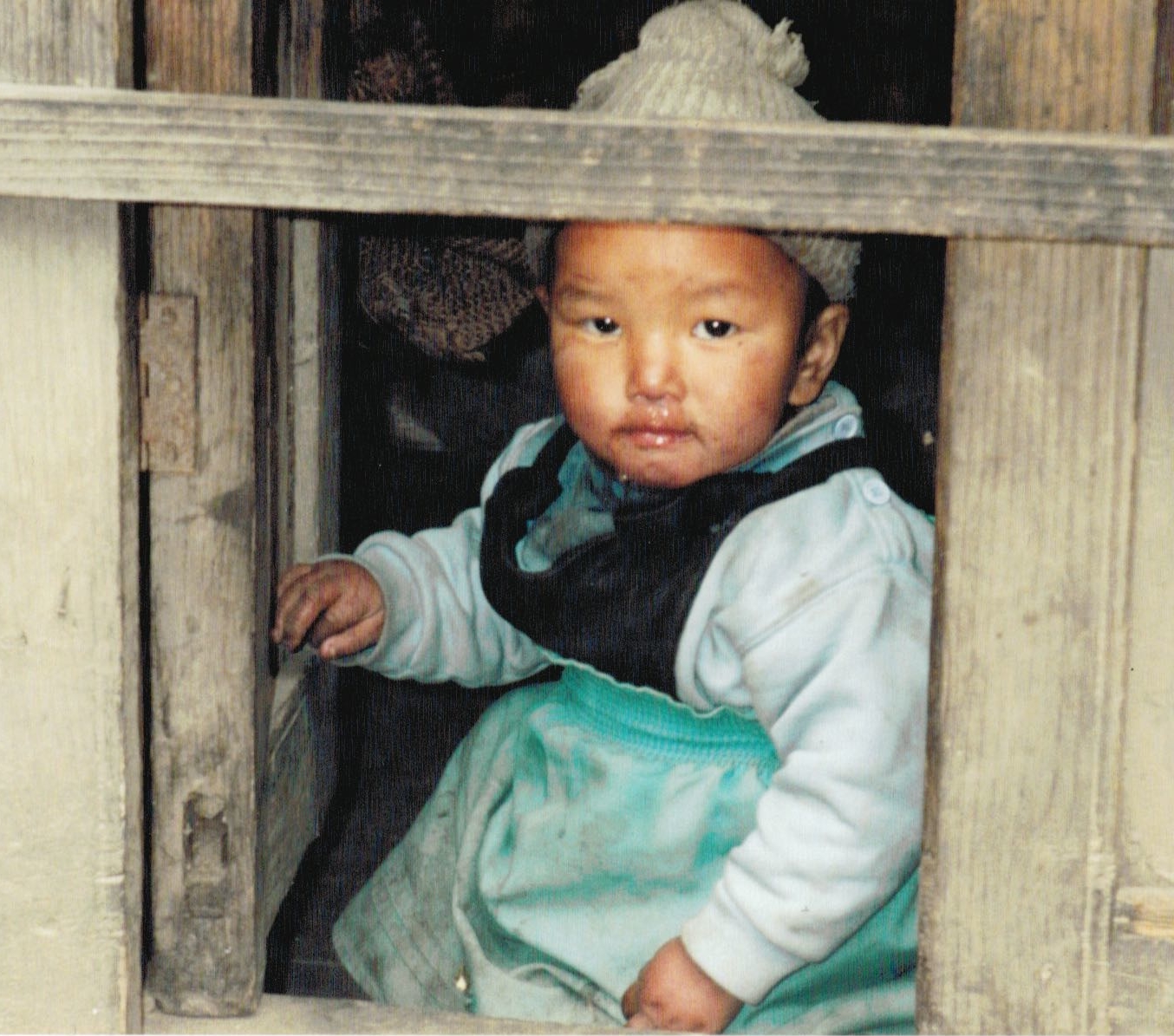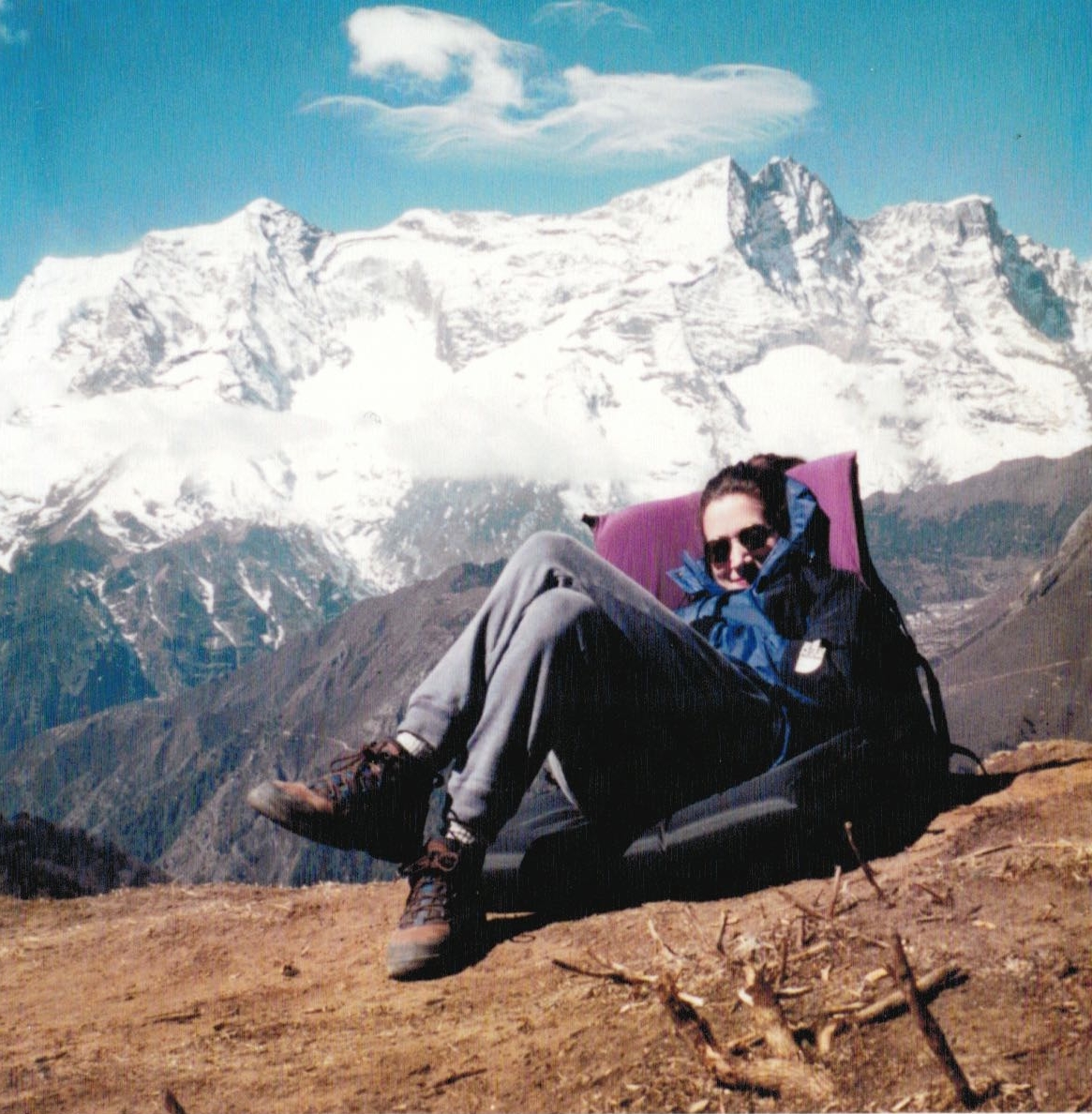Nepal
By: Jennifer Milano, written December 2015, traveled 1999 & 1997
A Sherpa baby in the doorway of her home, Everest region, Nepal
Eyes of Kathmandu, on a temple in Nepal's capital
I recall in vivid detail my first taxi ride in 1997 from Kathmandu airport to Thamel, the district of Nepal's capital where most backpackers stay. We drove along mostly unpaved streets lacking names and street signs. I gazed at the cars, motorbikes and three-wheeled trucks weaving in and out of traffic without apparent order. Women in brightly-colored saris and men in western-style clothes with flip flops on their feet walked along the streets. Cows wandered about. I remember smiling while I looked out of the window, amazed at where I was on the globe and just how different everything seemed in this Nepalese world.
I spent a total of about five weeks during that first trip to Nepal. With my trusted guide and new friend for life, K.P. Kafle, I trekked in the Everest region, which was a life-changing experience in so many aspects. It was the first time I had hiked, really hiked, for days. I found that despite gasping for air at 13,000 feet above sea level, there was something inexplicably relaxing about waking up each morning and having no other purpose to my day but to walk. And walking among the majestic, Himalayan peaks was awe-inspiring. But the most impactful part of my trek was the people I met along the way - both fellow travelers and local Sherpas (many people equate "Sherpa" with someone who carries your pack up Mt. Everest for you - while this is not untrue, more accurately a "Sherpa" is someone who hails from this region of the Himalayas, regardless of whether he or she works as a porter). I met teams of climbers on their way to Everest Base Camp to attempt the summit. I met Anatoli Boukreev, a Russian mountain climbing guide who earned fame through his role in the 1996 Everest disaster that claimed so many lives. (Nine months after I met Mr. Boukreev, I read in the New York Times that he died in an avalanche.) I met other trekkers like me, from all over the world.
The author in Tyangboche, Nepal 12,687 feet above sea level
But the people who amazed me the most were the Sherpas. As I walked each day, I passed by one-room, hand-built homes. I played with children who were covered in both dirt and smiles. I learned that while Americans spend their days going to work, school, activities, the grocery store and social events, the Sherpas spend their days living. They light fires for cooking and heat. They collect water for drinking and washing. They dig potatoes from the dirt for eating. They chisel stones for building. And they walk. There are no roads in the high mountains, only footpaths. They walk in bare feet or flip flops, carrying massive loads of materials from one village to the next. They are strong and hard-working human beings.
Sunrise over Mt. Everest (left); Lhotse and Nuptse (right)
Amadablam (Mother-Daughter), Nepal
Throughout my trek, I had the experience and support of K.P. Kafle, the most ideal guide you can imagine. K.P. is from Nepal, so has a local perspective. But he speaks fluent English, and spends every summer in the U.S. He offers a high level of service, but is friendly and fun to be with. K.P. made sure I drank plenty of water and walked slowly to acclimatize. He loaned me a -40 degree rated sleeping bag to ensure I stayed warm at night. On the night when I slept in a tent outside the teahouse alone to avoid being in the bunk room with a dozen male trekkers, he slept by the open doorway to make sure I was safe. To top it all off, K.P. donates 10% of his profits to SEEDS, a non-profit organization devoted to improving life for mountain dwellers. I was so taken with Nepal and K.P.'s treks that two years later, I returned to Nepal with a group of friends and family. K.P. led us on another amazing trek through a region called Helambu, an area that attracts hikers who want to focus their trip on connecting with locals and learning their culture.
In addition to trekking, I spent time in Kathmandu and the surrounding towns of Bhaktapur and Patan. I traveled into Tibet for a week, which was another amazing scenic and cultural experience. I also traveled south to Chitwan National Park, where I saw elephants, rhinos and bears, and from there, to the Annapurnas for day hikes.
Nepal is one of those places that draws you in. Every traveler I have met who has been to Nepal feels the same - that Nepal is a magical place with warm, friendly people whom you never forget. I am waiting until my children are a little bit older and can handle the hardships that come with traveling in Nepal (e.g. stomach upset, altitude sickness), before returning to show them the country I fell in love with. In the meantime, my children are learning about Nepal through their pen pal, a girl with whom K.P. put us in touch after discovering that she needed found an education sponsor. Even for those who don't plan to ever travel to Nepal, it is a country worth exploring virtually, as so many people there need help and support from the worldwide community. For details on how you can make a difference in a child's or a village's life in Nepal, see below for a link to the website for K.P.'s nonprofit organization. Namaste!
Before you Plan: Check the U.S. Department of State travel warnings (click here) and the Centers for Disease Control and Prevention's traveler information for Nepal (click here). While a relatively peaceful and safe country, Nepal has had politically-related violence in its not-so-distant past, and suffered a devastating earthquake in April 2015. Health-wise, you will want to discuss vaccinations with your physician, and ask about Diamox for altitude sickness and Cipro for treating bacterial infections in your stomach.
When to Go: The best times of year to trek in Nepal are November and March. The monsoon season runs from May through September. October is filled with Hindu celebrations, which can be both amazing and overwhelming, but is also a good month for trekking. December, January and February are also possible months to trek, but colder and snowier. In April, the views may be compromised by dust and haze.
How to Get Here: Most flights from the U.S. to Kathmandu connect in Bangkok. Once you are in Nepal, ask K.P. to help you with your internal travel arrangements.
Where to Stay & Eat: Short answer: ask K.P.! In the late 90's, I stayed at Hotel Utse in Kathmandu, a small Tibetan-run guesthouse that I loved at the time for its friendly staff, clean rooms and peaceful rooftop terrace. The hotel's restaurant was good, too. We had an authentic Newari meal at Thamel House, where we sat on cushions on the floor around a low table, and could choose a either the vegetarian or the meat-based menu. It was my first time trying wild boar, which I loved. Fire & Ice made decent pizzas, and Mike's Breakfast served American-style pancakes in an outdoor garden setting (although the owner and location has changed since I was there). The evening we returned to Kathmandu from our treks, we followed the trekkers' tradition and ate at Everest Steakhouse. My favorite bakery was Pumpernickel in the Thamel district, worth a trip even if you are staying elsewhere in the city. Bring your journal or a book and relax in an oasis from the madness of the city.
What to Do: Trek. Contact K.P. Kafle through his trekking company's website: http://heartofthehimalaya.com/index.html. Learn more about K.P.'s nonprofit organization here: http://www.nepalseeds.org/.
Mt. Everest from the air, above the clouds







